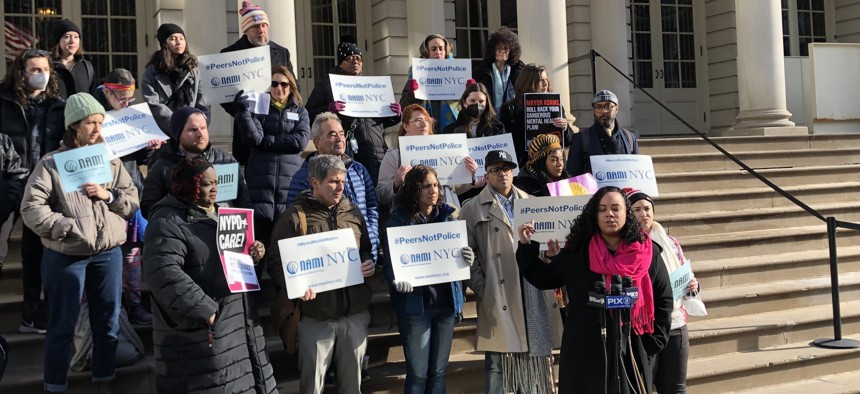New York City
No increase in mental health intakes yet from Adams’ involuntary removal plan
But Mayor Eric Adams’ administration couldn’t provide many specifics at a City Council oversight hearing on the removals

New York City Council Member Carmen De La Rosa speaks at a City Hall rally ahead of the oversight hearing on mental health involuntary removals, on Mon. Feb. 6. Jeff Coltin / City & State NY
New York City’s public hospitals haven’t recorded an increase in mental health intakes since Mayor Eric Adams’ Nov. 2022 directive to bring more severely mentally ill New Yorkers off the streets and into psychiatric care – underscoring the relatively small, limited impact of the mayor’s policy memo. But that announcement struck a nerve in a city that struggles to provide for the severely mentally ill, and the City Council held an oversight hearing Monday to get more information on the mayor’s plan for involuntary removals.
“Since November, we have not seen an increase in the number of patients coming to our emergency room,” testified Omar Fattal, system chief for behavioral health at New York City Health + Hospitals. He explained that the public hospitals are only part of the system, and that emergency teams could be bringing in New Yorkers to psychiatric evaluations at other hospitals too. However, “This is a very very small denominator of people we’re talking about who are homeless and have severe mental illness and are being targeted by this intervention. … Compared to the volume of people that we see, it’s very small in that context.”
Some health care workers and mental health advocates were concerned that police officers and mental health teams would overuse involuntary removals – and potentially slam emergency rooms. That doesn’t seem to be the case yet – but Fattal could not provide a count of how many people had been involuntarily admitted for psychiatric evaluation in the last two months. And that was just one of many data points that couldn’t be provided by representatives of the Adams administration from the Office of Community Mental Health, the police department, fire department and other agencies.
“Over the coming months we should have more numbers to share about what actually is happening on the ground and how that relates into what’s happening inside the hospitals,” said Jason Hansman, a deputy director in the Mayor’s Office of Community Mental Health, a message repeated over the course of the hearing.
Hansman also promised that a full plan – “a behavioral mental health agenda,” would be coming from City Hall “in early 2023.” Adams’ initial announcement was criticized by some mental health advocates for focusing on getting people off the street, with less consideration of what services would be provided after that. City Council Speaker Adrienne Adams initially didn’t even commit to holding an oversight hearing back in December, saying she was still waiting for a plan.
A major focus of the first two hours of the hearing was on whether police officers were properly trained to help the severely mentally ill. Cops are part of the mobile crisis teams responding to emergency calls and determining whether a person “displays an inability to meet basic living needs.” NYPD Chief of Training Juanita Holmes testified that 87% of all patrol officers had completed mental health training.
But to some progressives like Public Advocate Jumaane Williams, the city would be better off trying to minimize police involvement with the severely mentally ill.
“The system we have is unfair to police officers themselves as well. Most of them don’t want to be responding to this and they don’t have the tools to respond to these things. And it’s unfair to the people they’re trying to serve,” he told City & State after speaking at the hearing. “But we keep doing this over and over.”
The hearing came a week after a federal judge issued a ruling denying some advocates’ efforts to block Adams’ directive, allowing the policy to stand.

